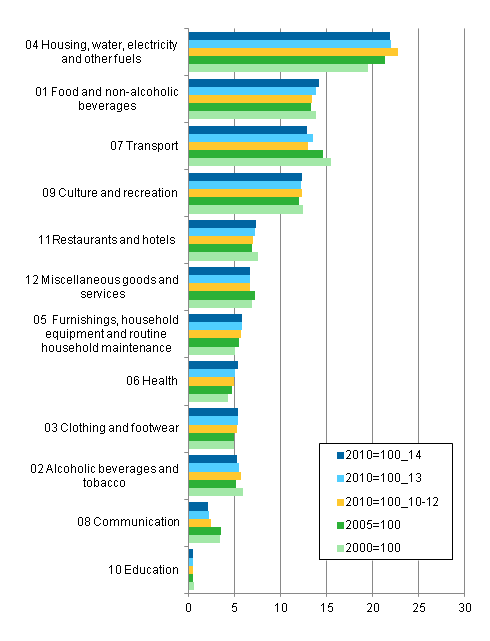The weight structure of The Consumer Price Index was updated
The weight structure of the Consumer Price Index is based on National Accounts data. The data are updated yearly, and the weight structure for 2014 corresponds to the value of private consumption in 2013, EUR 94.4 billion. From EUR 56.5 billion of the year 2000=100 index private consumption has grown in nominal terms by nearly seventy per cent, in real terms by a good thirty per cent.
The weights of the Consumer Price Index are composed of the value of goods and services bought by households in Finland. These households also include tourists and institutional households. The concept of private consumption in the Consumer Price Index differs from the concepts used in National Accounts and the Household Budget Survey and its coverage is also different.
The price development of selected commodities is monitored in the index. With the help of annually updated commodities and weights, better representation of commodities in the index is ensured. Previously, the weight structure of the Consumer Price Index was updated every five years. The last big scheduled update was made at the beginning of 2011, when a larger proportion of commodities were changed. At the beginning of 2014, new commodities in the index are pork sirloin and tablet computer. In addition, sugar-free juice concentrate and sugar-free soft drink were distinguished as separate commodities from concentrates and soft drinks.
Figure 1. Comparison of the weight structures of Consumer Price Indices 2010=100, 2005=100 and 2000=100, per cent

The largest change in the weight structure of the index from the previous year was the decreased share of transport. Changes in the prices of commodities in this group have now a lesser effect on the Consumer Price Index than before. Similarly, as the weight shares of health and food increase, changes in the prices of these commodity groups affect the Consumer Price Index more than before.
The base year of the Harmonised Index of Consumer prices remained unchanged
Statistics Finland has also revised the weight structure and commodity basket of the Harmonised Index of Consumer Prices calculated for Eurostat, the Statistical Office of the European Communities. The year 2005 remains as its base year.
The Harmonised Indices of Consumer Prices are primarily used in price comparisons between the EU countries. The European Central Bank uses the Harmonised Index of Consumer Prices as the measure of inflation in its monetary policy.
The Harmonised index of Consumer Prices is based on the same weight and price data as the national Consumer Price Index, but its commodity selection is narrower: it excludes owner-occupancy, games of chance, interests and tax-like payments. The Harmonised Index of Consumer Prices covers under 90 per cent of the national Consumer Price Index.
Table 1. Consumption items removed from the Harmonised Index of Consumer Prices and their weights in Consumer Price Index 2014
| COICOP | Commodity/group | Weight in the CPI, o/o |
| 04.2 | Owner-occupied housing | 7.23 |
| 07.2.4.2.1.1 | Vehicle tax | 1.10 |
| 09.4.3.1.1.1 | Games of chance | 2.04 |
| 12.5.2.1.1.2 | Premium for fire insurance on detached houses | 0.06 |
| 12.6.2.1.1.2 | Interests on consumer credits | 0.94 |
| Removed from HICP, total | 11.37 | |
Source: Consumer Price Index, Statistics Finland
Inquiries: Juhani Pekkarinen 09 1734 3476, Mari Ylä-Jarkko 09 1734 3310, khi@stat.fi
Director in charge: Leena Storgårds
Updated 19.2.2014
Official Statistics of Finland (OSF):
Consumer price index [e-publication].
ISSN=1799-0254. January 2014,
The weight structure of The Consumer Price Index was updated
. Helsinki: Statistics Finland [referred: 26.4.2025].
Access method: http://stat.fi/til/khi/2014/01/khi_2014_01_2014-02-19_kat_001_en.html

